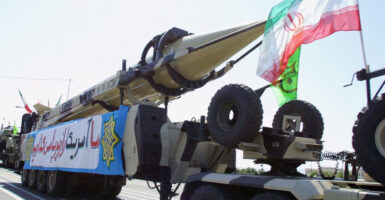On just about any list of international “bad actors,” North Korea and Iran certainly make the cut—and any news of them working together (and likely against the U.S. and our friends) is quickly put in the category of “trouble.”
So you can imagine the concern recently when an unidentified U.S. official told the press that: “Iran and North Korea have resumed cooperation on a long-range missile project, including the transfer of critical parts.”
Unfortunately, despite intense interest in any new tidbit on the Pyongyang-Tehran axis, the official declined to offer up which long-range missile program this is or when this cooperation started, stopped—and then resumed.
Of course, since North Korea already has an intercontinental ballistic missile capability, it can be assumed that the joint program is directed toward helping Iran develop a long-range missile.
Now, it’s been known for a long time that North Korea and Iran have had a highly secretive security relationship, including the transfer of weapons and technology—but mostly moving from Pyongyang to Tehran.
For instance, the Iranian Shahab 3 medium-range ballistic missile is based on the North Korean No Dong 1. That missile relationship goes all the way back to the 1990s, and clearly continues.
In its naval inventory, Iran also has a number of Ghadir mini-submarines based on the North Korean Yono-class design. Improving on the Yono, the Ghadir is capable of firing the Jask anti-ship cruise missile.
Of course, another big concern is nuclear cooperation.
While there’s scant public info on their collaboration, Iran clearly has nuclear ambitions and North Korea is willing to proliferate nuclear know-how off the Korean Peninsula, as evidenced by the reactor it was building for Syria, before the Israelis destroyed it in 2007.
Some similar cooperation must be assumed.
The trouble with any joint Iran-North Korea effort is that the exchange of ideas and technology between them could serve to accelerate the development and deployment of any number of weapon systems, even outpacing the best U.S. and allied intelligence assessments.
For instance, based on its past and current nuclear and missile activities, Iran would certainly like North Korea’s help on ICBMs or even North Korean nuclear warhead design to be put atop them.
But the relationship doesn’t go just one way.
For its part, Pyongyang would likely welcome an assist on the acquisition or development of unmanned combat aerial vehicles (drones) and land- and sea-based cruise missiles, all Iranian strengths.
Moreover, with North Korea’s work on ballistic missile submarines and submarine-launched ballistic missiles, there’s room for cooperation there as well with Iran. One North Korean submarine-launched ballistic missile has a range of 2,000 kilometers.
Indeed, it’s possible that we might see a test launch of a North Korean submarine-launched ballistic missile from a barge or a submarine around Oct. 10, the anniversary of the founding of the Korean Workers’ Party.
Of course, according to Washington’s special envoy for Iran, Elliott Abrams, “The United States is concerned about Iran’s cooperation with North Korea and will do whatever it can to prevent it.”
And it should.
So it makes sense that the Trump administration has reinstituted punitive economic sanctions on Iran over its bad behavior, including attempting to extend the international arms embargo on Tehran.
On North Korea, while already heavily sanctioned by the U.S., the administration should do more to enforce its current sanctions regime on Pyongyang to influence its behavior, including its partnership with Tehran.
Clamping down on North Korea and Iran through punitive sanctions and other means won’t stem their cooperation completely, but any effort to slow this perfidious partnership will advance our national security.

























